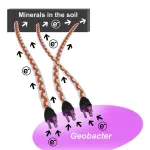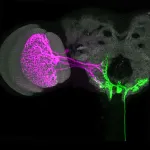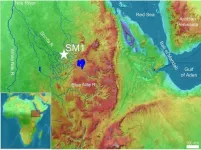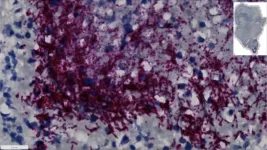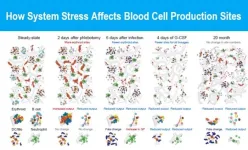(Press-News.org) To “breathe” in an environment without oxygen, bacteria in the ground beneath our feet depend upon a single family of proteins to transfer excess electrons, produced during the “burning” of nutrients, to electric hairs called nanowires projecting from their surface, found by researchers at Yale University and NOVA School of Science and Technology, NOVA University Lisbon (NOVA-FCT).
This family of proteins in essence acts as plugs that power these nanowires to create a natural electrical grid deep inside the Earth, which enables many types of microbes to survive and support life, said co-senior authors of the new study Nikhil Malvankar, associate professor of Yale’s Molecular Biophysics and Biochemistry Department and Microbial Sciences Institute, and Carlos Salgueiro, Full Professor at NOVA-FCT.
Malvankar’s lab and Salgueiro’s lab have extensively studied the components of this microbial electrical grid. However, it was unclear how bacteria can transmit excess electrons produced by metabolic activity into nanowires projecting from their surface and connecting with minerals or neighbors. They found that many kinds of soil bacteria depend upon a single, widespread family of cytochromes inside their bodies to charge nanowires.
Understanding the details of this nanowire charging is important for the potential development of new energy sources and new biomaterials and its impact on the environment. Malvankar and Salgueiro note that microbes absorb 80% of methane in the ocean, a major contributor to global warming, emitted from ocean floors. However, microbes on Earth’s surface account for 50% of methane emissions into the atmosphere. Understanding different metabolic processes might help mitigate methane emissions, they said.
The research was reported in the journal Nature Communications. This work was led by co-first authors Pilar Portela and Catharine Shipps, along with Cong Shen and Vishok Srikanth.
END
Deep Earth electrical grid mystery solved
2024-03-20
ELSE PRESS RELEASES FROM THIS DATE:
Metformin during pregnancy affects the brain development in offspring mice
2024-03-20
With the rise in gestational diabetes and metabolic disorders during pregnancy, metformin is also being prescribed more frequently. Although it is known that the oral antidiabetic agent can cross the placental barrier, the impacts on the brain development of the child are largely unknown. An interdisciplinary research team from the German Institute of Human Nutrition Potsdam-Rehbrücke (DIfE) have now been able to demonstrate in a mouse model that although metformin has positive effects in pregnant animals, it does not in the offspring. The results were published in the specialist journal ‘Molecular ...
Exposure to tobacco before birth significantly increased risk of Type 2 diabetes in adults
2024-03-20
Research Highlights:
Exposure to tobacco before birth and beginning smoking during childhood or adolescence were significantly associated with the development of Type 2 diabetes in adulthood, according to a study of nearly half a million adults in the UK Biobank.
Among those exposed to tobacco before birth or who began smoking during childhood or adolescence, participants who had a genetic predisposition to develop Type 2 diabetes and started smoking in childhood or adolescence had the highest risk of developing Type 2 diabetes.
Embargoed until 10:30 a.m. ...
In flies, a single brain cell can drive multiple movements of the body
2024-03-20
NEW YORK, NY — Motor neurons are the cells the brain uses to command muscles to act. Scientists typically thought of them as simple connections, much like the cables that link computers with their accessories. Now, in fly studies, researchers at Columbia's Zuckerman Institute have discovered that single motor neurons can each direct an insect’s body to move in far more complex ways than previously thought.
The findings were published in Nature on March 20.
"This is one of the first times scientists have analyzed in 3D what single motor neurons do ...
Toba supereruption unveils new insights into early human migration
2024-03-20
Modern humans dispersed from Africa multiple times, but the event that led to global expansion occurred less than 100,000 years ago. Some researchers hypothesize that dispersals were restricted to “green corridors” formed during humid intervals when food was abundant and human populations expanded in lockstep with their environments. But a new study in Nature, including ASU researchers Curtis Marean, Christopher Campisano, and Jayde Hirniak, suggests that humans also may have dispersed during arid intervals along “blue highways” created by seasonal rivers. Researchers also found evidence of cooking and stone tools that represent the oldest evidence of archery.
Working ...
Bacteria subtype linked to growth in up to 50% of human colorectal cancers, Fred Hutch researchers report
2024-03-20
Researchers at Fred Hutchinson Cancer Center have found that a specific subtype of a microbe commonly found in the mouth is able to travel to the gut and grow within colorectal cancer tumors. This microbe is also a culprit for driving cancer progression and leads to poorer patient outcomes after cancer treatment.
The findings, published March 20 in the journal Nature, could help improve therapeutic approaches and early screening methods for colorectal cancer, which is the second most common cause of cancer deaths in adults in the U.S. according to the American Cancer Society.
Examining colorectal cancer tumors removed from ...
Reducing the side effects of breast and ovarian cancer treatment
2024-03-20
Some anti-cancer treatments not only target tumour cells but also healthy cells. If their effects on the latter are too strong, their use can become limiting. A team from the University of Geneva (UNIGE), in collaboration with Basel-based FoRx Therapeutics, has identified the mechanism of action of PARP inhibitors, used in particular for breast and ovarian cancer in patients carrying the BRCA gene mutation. These inhibitors block two specific activities of the PARP proteins. By blocking one of them, the toxic effect on cancer cells is maintained, while healthy cells are preserved. This work, published in the journal Nature, will help improve the efficacy of these treatments.
Despite ...
Skeleton-wide study of blood cell formation yields surprising findings
2024-03-20
Imagine being able to count the different types of blood cells being formed inside the tiny bones of a mouse and pinpointing the strings and clusters of cells within the bone marrow that are responsible for producing specific types of blood cells.
That’s exactly what a team of scientists led by experts at Cincinnati Children’s achieved in a far-reaching study published March 20, 2024, in the prestigious journal Nature. Their work adds unprecedented new understanding of the “elegant” and “resilient” anatomy of bone marrow while also generating evidence of unexpected variations in how the skeleton ...
MD Anderson Research Highlights for March 20, 2024
2024-03-20
HOUSTON ― The University of Texas MD Anderson Cancer Center’s Research Highlights showcases the latest breakthroughs in cancer care, research and prevention. These advances are made possible through seamless collaboration between MD Anderson’s world-leading clinicians and scientists, bringing discoveries from the lab to the clinic and back.
Recent developments at MD Anderson offer insights into a combination therapy that slows pancreatic cancer progression, an all-oral treatment for older patients with acute myeloid leukemia (AML) unable to receive intensive chemotherapy, novel targets to protect against osteoporosis and bone metastasis, the generation ...
An endless domino effect
2024-03-20
If it walks like a particle, and talks like a particle… it may still not be a particle. A topological soliton is a special type of wave or dislocation which behaves like a particle: it can move around but cannot spread out and disappear like you would expect from, say, a ripple on the surface of a pond. In a new study published in Nature, researchers from the University of Amsterdam demonstrate the atypical behaviour of topological solitons in a robotic metamaterial, something which in the future may be used to control how robots move, sense their surroundings and communicate.
Topological solitons can be found in many ...
ARPA-H appoints Etta Pisano to lead its Advancing Clinical Trials Readiness Initiative
2024-03-20
The Advanced Research Projects Agency for Health (ARPA-H) has appointed Etta D. Pisano, MD, FACR, senior portfolio lead, to build the agency's clinical trial portfolio and lead the ARPA-H Advancing Clinical Trials Readiness Initiative under ARPA-H Resilient Systems Mission Office Director Jennifer Roberts.
The first radiologist to be appointed to such a role, Dr. Pisano is an internationally recognized expert in women's health, breast cancer research, and the use of artificial intelligence in ...
